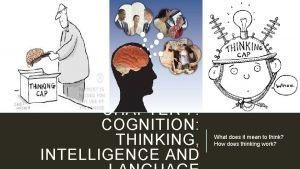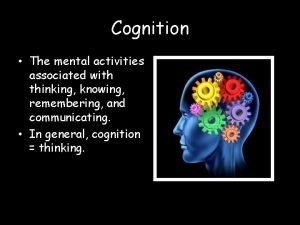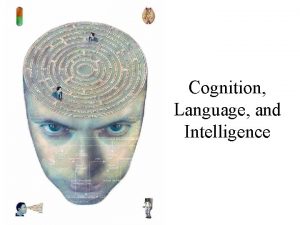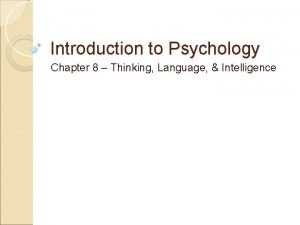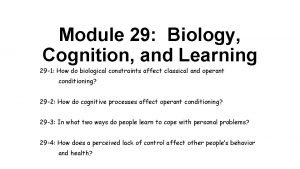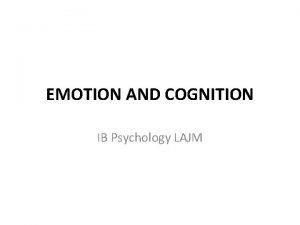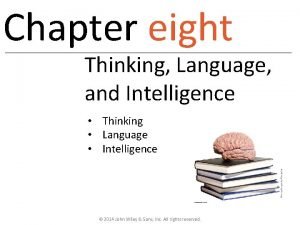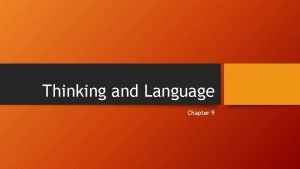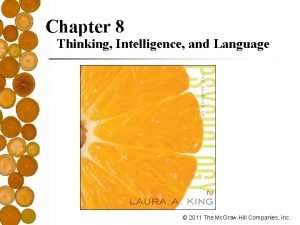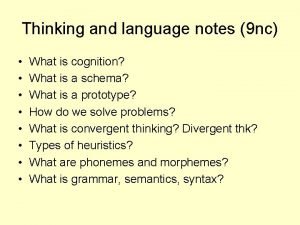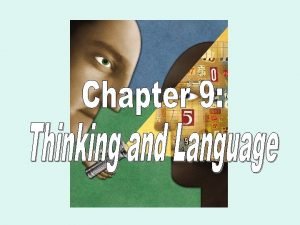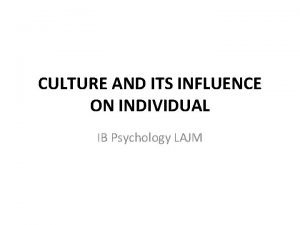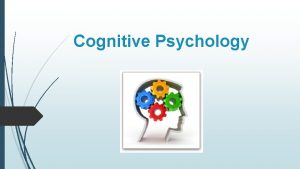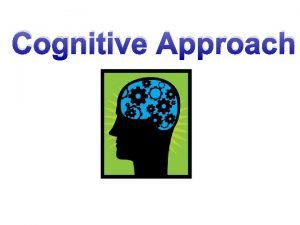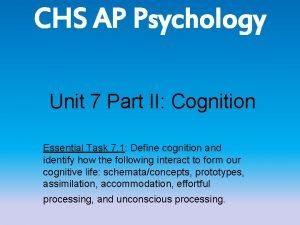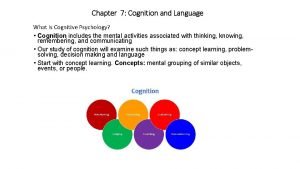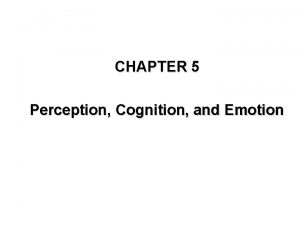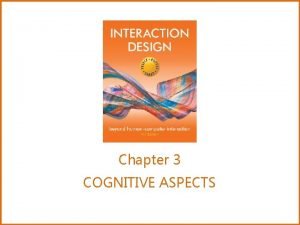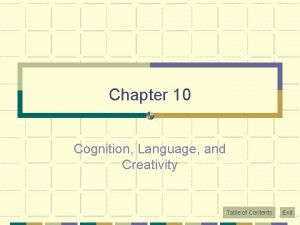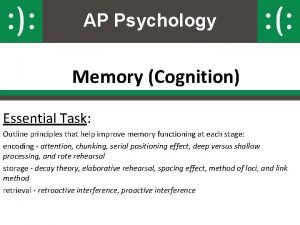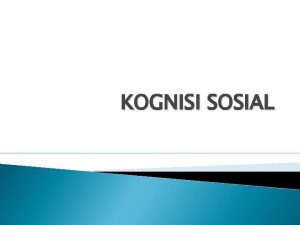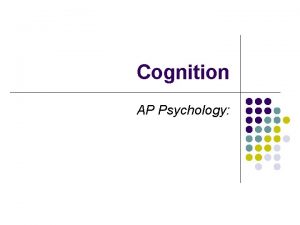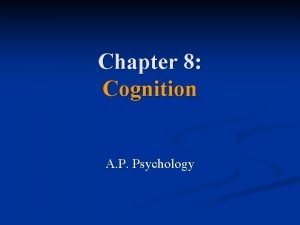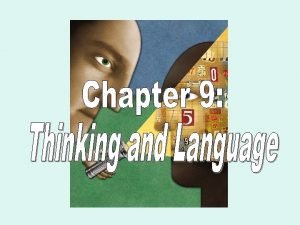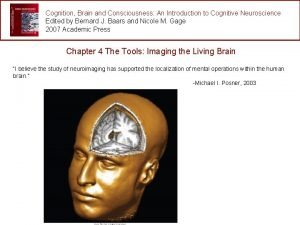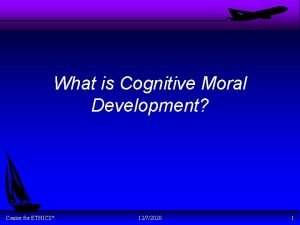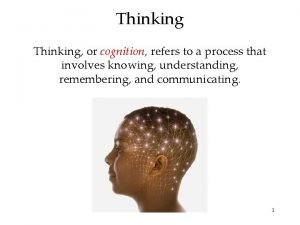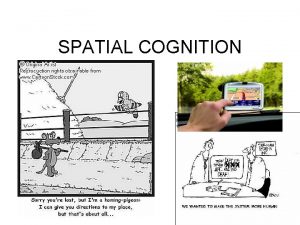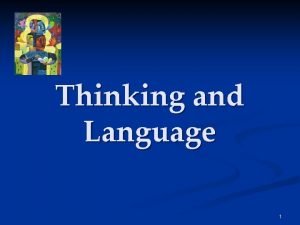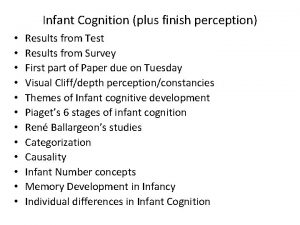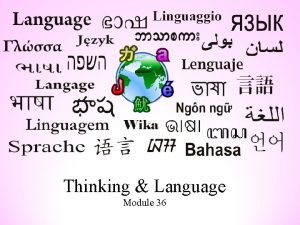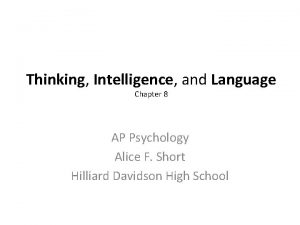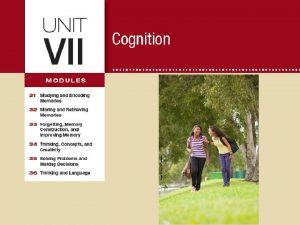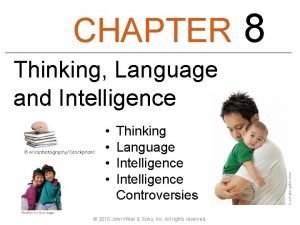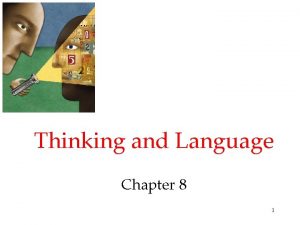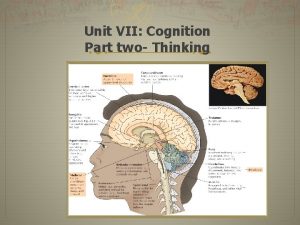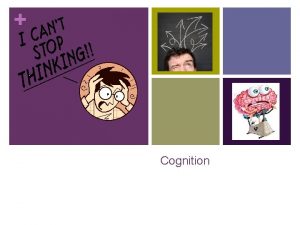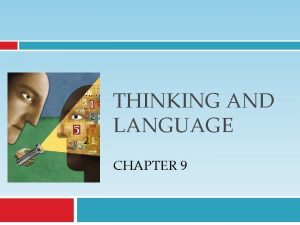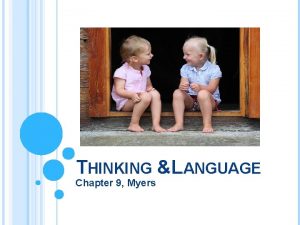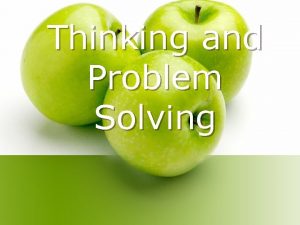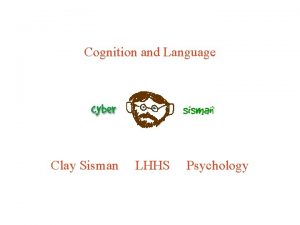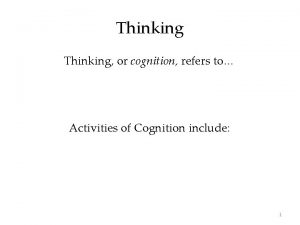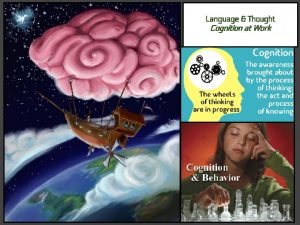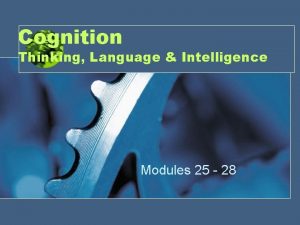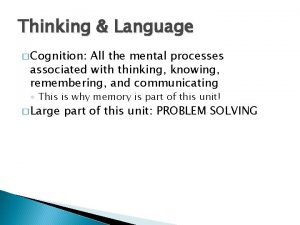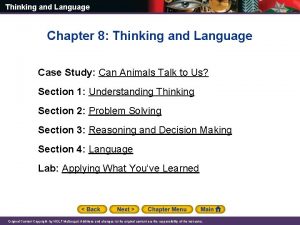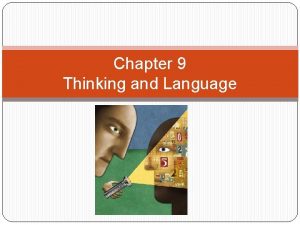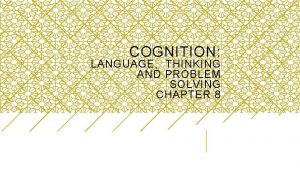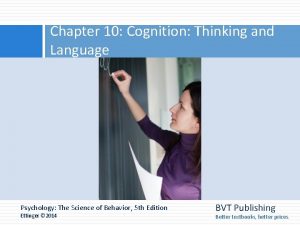Chapter 10 Thinking and Language Thinking Cognition all

















































- Slides: 49

Chapter 10: Thinking and Language

Thinking Cognition – all the mental activities associated with thinking, knowing, remembering, and communicating Cognitive Psychologists study these mental activities, including the logical and illogical ways we create concepts, solve problems, make decisions, and form judgments

Thinking - Concepts We simplify things when thinking about everything in the world. Concepts – mental groupings of similar objects, events, ideas, and people – they share a common feature Concepts make life easier; they simplify things into classifications ◦ Example – concept of a chair – 4 legs, seat, for sitting

Thinking - Concepts • To further simplify things, we organize concepts into hierarchies • Think of major cities, organized first into sectors, then neighborhoods, and then into individual streets.

Thinking - Prototypes – a mental images or best example that incorporates all the features associated with a category • We match new items to an existing prototype to provide a quick and easy method for putting things into categories Examples: ◦ Prototype of triangles = anything with 3 sides ◦ Prototype of birds – small, feathered, flying, come from eggs

Thinking - Prototypes Move away from our prototype, and categories may have fuzzy boundaries Fruit? Fish? Bird? Ball?

Thinking – Solving Problems • Trial and Error • Algorithms – methodical, step-by-step procedures that guarantee a solution for solving a problem • Takes time • Heuristics – simple thinking strategy that often allows us to make judgements and solve problems efficiently (rule of thumb strategy – mental shortcut) • Usually speedier but also more error-prone than algorithms Ex. SPLOYOCHYG

Solving Problems - Creativity – the ability to use information in a way that results in new, original thinking Robert Sternberg’s 5 Components of Creativity: • Expertise - well developed base of knowledge • Imaginative thinking skills - provide the ability to think in novel ways, recognize patterns, and to make connections • A venturesome personality - seeks new experience, tolerates ambiguity & risk • Intrinsic Motivation - driven more by interest, satisfaction, and challenge than external pressures • A Creative Environment

Solving Problems - Kinds of Thinking Convergent thinking - systematic and logical attempt to reach a specific goal ◦ Relies heavily on symbols, concepts, and other rules ◦ Deliberate and purposeful – 1 correct answer Divergent thinking – thinking without a goal or a plan; ability to consider many different options & think in novel ways ◦ Depends more on imagery and feelings ◦ Often done when relaxing – may provide insights Metacognition – thinking about thinking; active awareness of our thought process

Thinking – Solving Problems Insight – a sudden and often novel realization of the solution to a problem • Not strategy based • Sudden flash of inspiration – the “Aha moment” • Research shows a burst of right temporal lobe activity when solutions occur with sudden insight. • Wolfgang Kohler – human not only creatures to display insight (Sultan the chimpanzee)

Thinking – Obstacles to Solving Problems • Many cognitive tendencies that we think are taking us in the right direction can often give us wrong answers. • Confirmation Bias and Fixation often lead us astray. • Confirmation Bias – tendency to search for info that confirms our preconceptions • We seek evidence verifying our ideas more eagerly than evidence that might refute them • Example: You are in a debate or argument with a friend and you deliberately point out evidence that proves your point and try to overlook or notice evidence that counters your argument.

Thinking – Obstacles to Solving Problems Confirmation Bias –

Thinking – Obstacles to Solving Problems Fixation – The inability to see a problem from a fresh perspective by employing a different mental set. • Fixation constrains our perceptions of objects and limits our thinking. Types of Fixation – Mental Set and Functional Fixedness • Mental Set – predisposes how we think; the tendency to approach a problem in one particular way, especially a way that has been successful in the past Example: O-T-T-F-? -? -? E-O-E-R-E-X-N-? Sometimes what worked in the past hinders our ability to find new solutions.

Thinking – Obstacles to Solving Problems Functional Fixedness – Our tendency to think of things only in terms of their usual functions; impeding our problem solving Example: How would you mount the candle on a bulletin board using these materials?

Thinking – Obstacles to Solving Problems How would you arrange six matches to form four equilateral triangles?

Functional Fixedness? ? How many uses can you find for these items?

Thinking – Using and Misusing Heuristics Our mind’s automatic processing uses heuristics to make quick judgment decisions, but sometimes quick decisions can lead us to make bad decisions. Representative Heuristic – rule of thumb for judging the likelihood of things in terms of how well they seem to match or represent particular prototypes or stereotypes ◦ May lead one to ignore other relevant information.

Thinking – Using and Misusing Heuristics Representative Heuristic – Examples • You see a really tall person and assume that they play basketball because they fit your prototype of a basketball player. • Linda is 31, single, outspoken and very bright. She majored in philosophy in college. As a student she was deeply concerned with discrimination and other social issues, and she participated in antinuclear demonstrations. Which statement is more likely? A. Linda is a bank teller. B. Linda is a bank teller and active in the feminist movement.

Thinking – Using and Misusing Heuristics Availability Heuristic – Estimating the likelihood of events based on their availability in the memory • If instances come readily to mind (perhaps because of their vividness), we presume such events are common. • Examples: airplane crashes, terrorist attacks, school shootings • Example: Casinos make a big deal about even small wins so that we are more likely to remember them than the losses which occur more often.

Thinking – Using and Misusing Heuristics

Availability Heuristic Which causes more deaths per 100, 000? 1. All accidents or strokes? 2. Blood poisoning or suicide? 3. Homicide or diabetes? 4. Motor vehicle accidents or colorectal cancer? 5. Leukemia or Drowning?

Availability Heuristic Which city has the higher crime index? 1. Chicago or Baltimore? 2. Manhattan or Gary, Indiana 3. Boston or Flint? 4. Montreal or Hot Springs? 5. San Francisco or Durham?

Availability Heuristic Example

Thinking - Overconfidence – The tendency to be more confident than correct; to overestimate the accuracy of our knowledge and judgments • We fail to appreciate our potential for error • Often happens right after a test you have taken – we tend to overestimate our performance ◦ • Example - American confidence before Vietnam, Iraq • Example – Students estimating how quickly they can complete an assignment

Thinking - Overconfidence • Warning people against overconfidence doesn’t do much to reduce the overconfidence. • Value of overconfidence – People who err on the side of overconfidence live more happily, find it easier to make tough decisions, and seem more credible. • People learn to assess their accuracy more realistically if given prompt, clear feedback on the accuracy of their judgements.

Thinking – Framing Decisions • Framing – The way an issue is posed can significantly affect decisions and judgements. • Examples: • Ground beef described as 75% lean vs. 25% fat • 10% of people will die undergoing this surgery vs. 90% survival rate • People express more surprise when a 1 in 20 event happens than when an equivalent 10 in 200 event happens. • “Aid to the needy” vs. “welfare”

Thinking – Framing Decisions • People who understand the power of framing can use it to influence important decisions • Example: $150 coat in store X marked down to $100 vs same coat in store Y regularly priced at $100 • To scare people, frame risks as numbers, not percentages • Example: Chemical exposure is projected to kill 10 of every 10 million people.

Thinking – Belief Bias & Belief Perseverance Belief Bias – The tendency for one’s preexisting beliefs to distort logical reasoning • Sometimes make invalid conclusions seem valid or valid conclusions seem invalid • We find it easier to accept conclusions that agree with our opinions • Belief perseverance – Our tendency to cling to our beliefs in the face of contrary evidence (often fuels social conflict) • Once our beliefs form and get justified, it takes more compelling evidence to change them than it did to create them.

Thinking – Intuition – an effortless, immediate, automatic feeling or thought • Fast, unreasoned – not explicit, conscious reasoning (gut feeling) • An innate inclination toward a particular behavior, as opposed to a learned response. • It is noticeable enough to be acted on (if one chooses to) without us being fully aware of the underlying reasons for its occurrence. • Allows us to react quickly and usually adaptively (instinct vs reason).

Thinking - Intuition • Good for some things like reading emotions in faces, but not so good at others, such as assessing risks. • Relying on gut feelings doesn’t always lead to good decisions. • Smart thinkers will welcome their intuitions but also check them against valuable evidence.

Language §Language – Our spoken, written, or signed words and the ways we combine them as we think and communicate §Allows us not only to communicate, but to transmit civilization’s accumulated knowledge across generations. Allows us to know what we haven’t seen. §Unique to humans; “the jewel in the crown of cognition” §Your brain makes your mouth make noises, sending air waves to another person’s ear. They hear it and process it. §Transfer meaning from one mind to another

Language Structure - Phonemes Three building blocks: Phonemes, Morphemes, Grammar Structure • Phonemes – set of basic sounds, smallest distinctive sound unit Example: bat = b, a, t • Of 500 languages, 869 different phonemes in basic speech. No one language uses them all. • English uses 40, others half or double that

Language Structure - Phonemes • Changes in phonemes produces changes in meaning Example: b…. t (bat, but, bait, boat, etc. ) • Same letter can represent multiple phonemes Example: letter “a” in cake vs. cat • People who grow up learning one set of phonemes usually have difficulty pronouncing those of another language. • Sign language also has phoneme-like building blocks defined by hand shapes and movements.

Language Structure - Morphemes • Morphemes – The smallest unit of language that carries meaning • Most morphemes are combinations of two or more phonemes (I, a, plural s ending – phonemes that are also morphemes) • Can be a prefix or suffix: Pre– and –ed have meanings Examples: Overreact has 3 morphemes = Over / re / act

Language Development - Grammar • Grammar – Systems of rules (semantics and syntax) that enable us to communicate with and understand others • Semantics – Set of rules we use to derive meaning from morphemes, words, and even sentences Example: adding –ed to the end of word means it is past tense • Syntax – rules for ordering words into grammatically sensible sentences in a given language Example: adjectives before nouns in English – We say white house instead of house white

Language Development • Between birth and high school graduation, you learn 60, 000 words (average 10 per day) • You spoke in original and grammatically meaningful sentences before you could add 2+2 • You can adapt your language to your social context • You know your culture’s rules for speaking and listening

Language Development • Language development mirrors language structure – moves from simple to complex • Infants – without language - in fantis • By 4 months, babies can discriminate speech sounds, can read lips and faces, can recognize the shape of a mouth when we make ah or ee sounds • Receptive language – babies’ ability to comprehend speech • Productive language – babies’ ability to produce words – matures after receptive language

Language Development Babbling stage – (about 4 months) spontaneously utter a variety of sounds • Not an imitation of adult speech • Includes sounds from various languages and sounds that do not occur within the household • About 10 months, babbling begins to resemble sounds and intonations characteristic of the household language

Language Development • One-word stage - (around 1 st birthday) have learned that sounds carry meanings • If trained, can associate a word with an object or person • Begin to use sounds to communicate meaning – usually contain only one syllable – ma or da • Single word may equal a sentence – “Doggy!” may mean “Look at the dog out there!” • About 18 months, word learning expands from about a word a week to word a day

Language Development • Two-word stage – (before 2 nd birthday) begin using two-word sentences • Telegraphic speech – early form of speech that contains mostly nouns and verbs (like a telegram) Examples: “Want juice, ” “Get toy” • Follows the rules of syntax – words are in a sensible order Example: big doggy rather than doggy big • Eventually begin to speak in longer phrases


Language Development – Nature vs. Nurture • B. F. Skinner – Behavioral Theory (Operant Conditioning) • Language is developed by reinforcement and modeling or imitation ◦ Associate sights of things with sounds of words ◦ Imitate the words and syntax of others ◦ Child is reinforced with success, smiles, hugs when says something right

Language Development • Noam Chomsky (Linguist) – Inborn Universal Grammar • Language will occur naturally given adequate nurture • Our capacity for developing language is natural and quick because we all come “pre-wired” with a “language acquisition device” to use language. • There is a universal grammar that underlies all human language – same grammatical building blocks (nouns, verbs, etc. ) • We naturally start speaking in nouns

Language Development • Chomsky disagreed with Skinner’s theory – oversimplified • Doesn’t explain how children learn so many words and phrases so quickly that are never conditioned or modeled. • They generate sentences they have never heard, sometimes with errors • They tend to learn language at different developmental times which supports that some language development is innate

Language Development • Infants have the ability to learn statistical aspects of human speech • They can discern word breaks and statistically analyze which syllables go together • They can detect the difference between syllable patterns which suggests they come with a built-in readiness to learn grammar

Language Development Critical period – a critical or sensitive period of childhood to master certain aspects of language • After age 7, our window for learning certain aspects of language begins to close • After the critical period closes, learning a 2 nd language is difficult • Children have little or no accent compared to adults • Adults can master basic words and word order, but never become as fluent as native speakers with subtle grammar rules.

Language Development • If children have not been exposed to enough language after age 7, they have difficulty mastering a language • Example: Deaf children that get cochlear implants at age 2 develop oral speech better than if received at age 4 • Those not exposed to either spoken or sign language during their early years lose their ability to master any language. • Conclusion – When a young brain does not learn any language, its language-learning capacity never fully develops.

Language Development • Benjamin Whorf (linguist) – Linguistic determinism hypothesis – language determines the way we think • We think differently in different languages – not all cultures share the same words. Example: the idea of self has different words and meanings in English than it does in Japanese or Korean. • Thinking develops hand-in-hand with language – Difficult to think about or conceptualize certain abstract ideas without language.

Language Development Thinking in Images – • Sometimes we think in images, especially with procedural memory • Olympic athletes use mental practice as a part of training • Brain imaging shows that imagining a physical activity triggers action in the same brain areas that are triggered when actually performing the activity. • Final thought – Thinking affects our language, which then affects our thought.
 Chapter 7 cognition thinking intelligence and language
Chapter 7 cognition thinking intelligence and language Cognition thinking intelligence and language
Cognition thinking intelligence and language All the mental activities associated with thinking
All the mental activities associated with thinking Does language reflect intelligence
Does language reflect intelligence Wais
Wais Name three line segments
Name three line segments Module 29 biology cognition and learning
Module 29 biology cognition and learning Teacup ib psychology
Teacup ib psychology Cognition and personalization
Cognition and personalization When you group subcategories within broader concepts
When you group subcategories within broader concepts Belief perseverance
Belief perseverance Chapter 9 thinking and language notes
Chapter 9 thinking and language notes Chapter 8 thinking language and intelligence
Chapter 8 thinking language and intelligence Airline reservations typically decline after
Airline reservations typically decline after Belief perseverance
Belief perseverance Metal status exam
Metal status exam Mse in counseling
Mse in counseling Acculturation studies ib psychology
Acculturation studies ib psychology What is cognition
What is cognition Cognition definition
Cognition definition Embodied cognition ap psychology
Embodied cognition ap psychology Means end analysis psychology example
Means end analysis psychology example Objectives of perception
Objectives of perception Altered cognition in older adults is commonly attributed to
Altered cognition in older adults is commonly attributed to What is cognition
What is cognition Cognition definition
Cognition definition Chunking ap psychology examples
Chunking ap psychology examples Psychology unit 7
Psychology unit 7 Jalan pintas mental
Jalan pintas mental Embodied cognition ap psychology definition
Embodied cognition ap psychology definition Belief bias ap psychology
Belief bias ap psychology Embodied cognition ap psychology
Embodied cognition ap psychology Cognition refers to
Cognition refers to Consciousness
Consciousness Moral cognition
Moral cognition Cognitive dissonance definition
Cognitive dissonance definition Hippocampus taxi drivers
Hippocampus taxi drivers Cognition refers to
Cognition refers to Cognition plus
Cognition plus Positive thinking vs negative thinking examples
Positive thinking vs negative thinking examples Thinking about your own thinking
Thinking about your own thinking Holistic judgement
Holistic judgement Perbedaan critical thinking dan creative thinking
Perbedaan critical thinking dan creative thinking Thinking about you thinking about me
Thinking about you thinking about me She's all states and all princes i nothing else is
She's all states and all princes i nothing else is Written
Written Ap psychology thinking language and intelligence
Ap psychology thinking language and intelligence Module 36 thinking and language
Module 36 thinking and language Language
Language Thinking affects our language, which then affects our:
Thinking affects our language, which then affects our:

